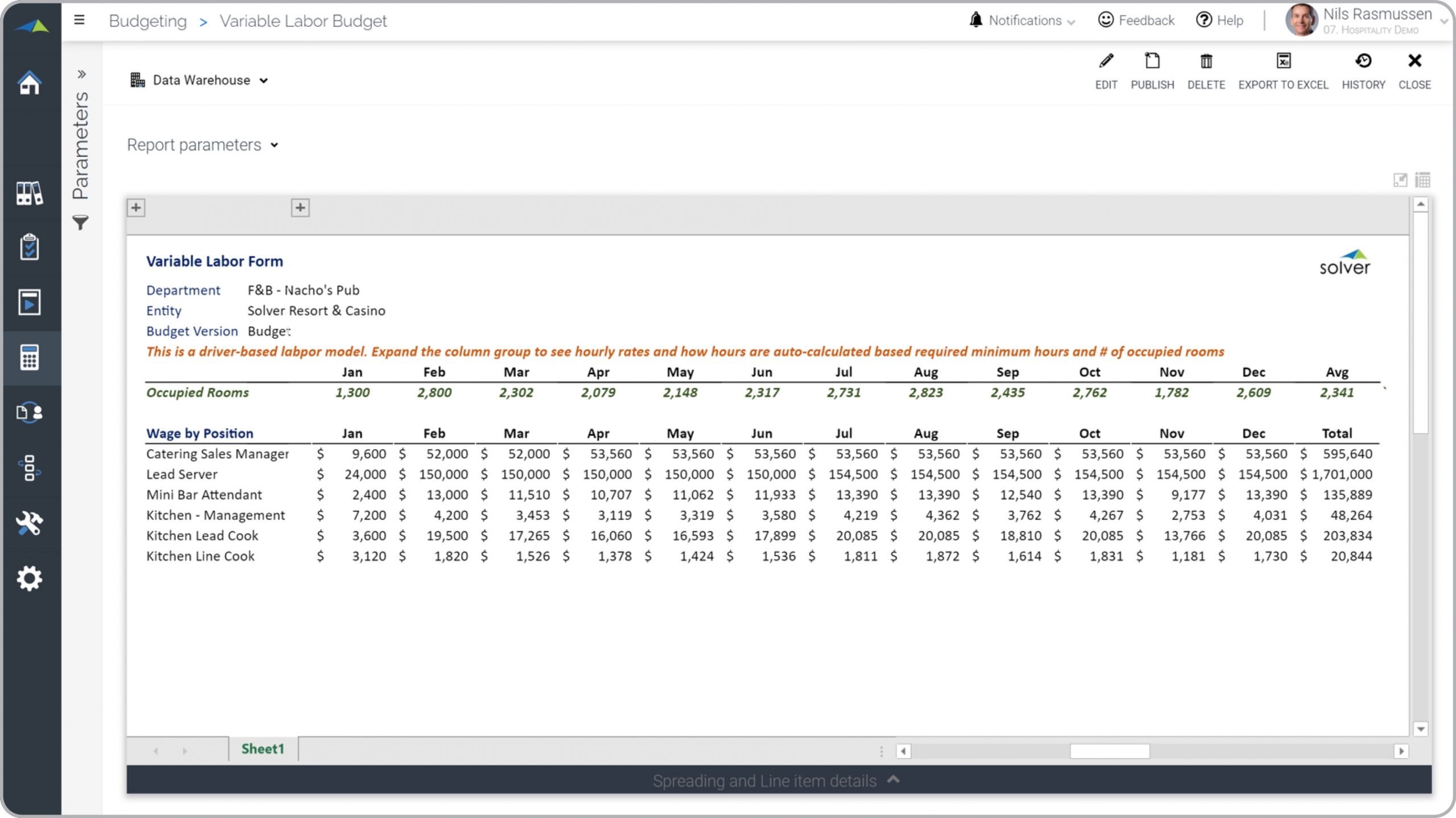Variable Labor Budget Model for Hospitality Companies
What is
a
Variable Labor Budget Model
? Variable Labor Budget Models are considered planning and forecasting tools and are used by budget managers and department heads to capture wages by position. Some of the main functionality in this type of input form is that it is uses drivers (typically from an assumptions template) like hourly rates, max/min hours and room occupancy to calculate the labor expenses. You find an example of this type of input form below.
Purpose of
Variable Labor Budget Models Hospitality companies use Variable Labor Budget Models to automate the capturing of detailed labor budgets by department and business unit. When used as part of good business practices in FP&A departments, a company can improve its budget accuracy, and it can reduce the chances that labor expenses are over- or under estimated.
Example of a
Variable Labor Budget Model Here is an example of a departmental input form for Variable Labor Wages. [caption id="" align="alignnone" width="2560"]
 Example of a Variable Labor Budget Model for Hospitality Companies[/caption] You can find hundreds of additional examples
here
Who Uses This Type of
Input form
? The typical users of this type of input form are: Budget managers, HR managers, department heads.
Other Reports Often Used in Conjunction with
Variable Labor Budget Models Progressive FP&A departments sometimes use several different Variable Labor Budget Models, along with Employee payroll budgets, human capital planning models, profit & loss budgets, historical financial statements, budget analysis dashboards and other management and control tools.
Where Does the Data for Analysis Originate From? The Actual (historical transactions) data typically comes from enterprise resource planning (ERP) systems like: Microsoft Dynamics 365 (D365) Finance, Microsoft Dynamics 365 Business Central (D365 BC), Microsoft Dynamics AX, Microsoft Dynamics NAV, Microsoft Dynamics GP, Microsoft Dynamics SL, Sage Intacct, Sage 100, Sage 300, Sage 500, Sage X3, SAP Business One, SAP ByDesign, Acumatica, Netsuite and others. In analyses where budgets or forecasts are used, the planning data most often originates from in-house Excel spreadsheet models or from professional corporate performance management (CPM/EPM) solutions.
What Tools are Typically used for Reporting, Planning and Dashboards? Examples of business software used with the data and ERPs mentioned above are:
Example of a Variable Labor Budget Model for Hospitality Companies[/caption] You can find hundreds of additional examples
here
Who Uses This Type of
Input form
? The typical users of this type of input form are: Budget managers, HR managers, department heads.
Other Reports Often Used in Conjunction with
Variable Labor Budget Models Progressive FP&A departments sometimes use several different Variable Labor Budget Models, along with Employee payroll budgets, human capital planning models, profit & loss budgets, historical financial statements, budget analysis dashboards and other management and control tools.
Where Does the Data for Analysis Originate From? The Actual (historical transactions) data typically comes from enterprise resource planning (ERP) systems like: Microsoft Dynamics 365 (D365) Finance, Microsoft Dynamics 365 Business Central (D365 BC), Microsoft Dynamics AX, Microsoft Dynamics NAV, Microsoft Dynamics GP, Microsoft Dynamics SL, Sage Intacct, Sage 100, Sage 300, Sage 500, Sage X3, SAP Business One, SAP ByDesign, Acumatica, Netsuite and others. In analyses where budgets or forecasts are used, the planning data most often originates from in-house Excel spreadsheet models or from professional corporate performance management (CPM/EPM) solutions.
What Tools are Typically used for Reporting, Planning and Dashboards? Examples of business software used with the data and ERPs mentioned above are:
- Native ERP report writers and query tools
- Spreadsheets (for example Microsoft Excel)
- Corporate Performance Management (CPM) tools (for example Solver)
- Dashboards (for example Microsoft Power BI and Tableau)
Corporate Performance Management (CPM) Cloud Solutions and More Examples
August 15, 2021
TAGS:
Reporting,
Solver,
report writer,
Microsoft,
Payroll,
golf,
template,
practice,
Acumatica,
hospitality,
Netsuite,
Finance,
planning,
GP,
Business Central,
excel,
restaurant,
resort,
spa,
ax,
hotel,
forecast,
Budget,
Dynamics 365,
budgeting,
labor,
Cloud,
Software,
driver,
casino,
Tableau,
SAP,
example,
best,
input,
Sage,
BC,
D365,
NAV,
Intacct,
CPM,
report,
SL,
Management,
dynamics,
Power BI,
employee budget

